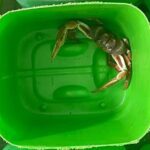If asked to think of the ecological role fish play in rivers and streams, there’s a good chance you will immediately think of the fish as a predator or possibly prey. But fish can play another crucial role in the ecosystem—they are mini fertilizing machines, delivering little packages of nutrients whenever they poop. This parcel of nutrients can stimulate plant growth—including phytoplankton, which forms the base of the food web.
Just how much nutrients one fish poops depends on many factors, including size. Per gram, small fish use fewer nutrients to grow compared to larger fish. The result? Gram for gram, small fish excrete more nutrients. But since small fish are, well, small, the actual amount excreted (the absolute excretion rate) is lower than in bigger fish.
Now, a new collaborative study from researchers Stéphanie Guernon, Matthew Yates, Dylan Fraser, and Alison Derry published in Canadian Journal of Fisheries and Aquatic Sciences shows that the genetic differences between populations of the same species that influence traits like body size are also important in determining the nutrient level in fecal matter.
“Most studies that have looked at the relationship between body size and excretion rate have really focused on broad comparisons between species or even broader taxonomic groups,” Derry noted. “But if you want to get at eco-evolutionary questions then you really need to look within a species.”
The researchers had the perfect subjects for their study—brook trout from Cape Race in Newfoundland, Canada. This rather remote barren is home to a plethora of ponds and streams, largely untouched by human activities like fishing. Crucially, not all these ponds and streams are connected, which means the trout in one stream can’t mingle with trout in another. And with the ponds and streams all being a little different from each other, each stream’s trout population has evolved a little differently. “In the deep streams, you have larger fish at maturity with an older age of maturity. In the shallower streams the selection is for smaller fish at maturity and an earlier age at reproduction,” Derry explained.
The team collected eggs and sperm from two populations of Cape Race trout—one from a deep stream and the other from a shallow stream. Making sure not to mix the populations, they fertilised the eggs and reared the offspring in captivity where they could control for factors like diet and temperature. When the trout reached half a year old (juveniles) and one and a half years old (adults), they measured the excretion rates of nitrogen, a very important nutrient
The trout whose parents came from the deeper stream still grew bigger than those whose parents came from the shallow stream. When comparing the average absolute individual excretion rate (the average amount of nitrogen actually excreted between the two populations), the researchers found no difference. On a per gram basis, however, things were a little different. The adults whose parents came from the shallower stream excreted more nitrogen on a per gram basis than those from the deeper stream, regardless of their size. Since the fish had lived in identical conditions since the moment of conception, this difference is likely due to genetics.
But the story doesn’t end there. The researchers predicted what the nitrogen contributions of each wild population would be to their streams. It seems that shallow-stream populations are contributing more. The reason for this is somewhat simple—the shallow-stream population has two to three times more individuals than the deep stream population.
Read the full paper:The coevolution of adult body mass and excretion rate between genetically size-divergent brook trout populations in the Canadian Journal of Fisheries and Aquatic Sciences.




